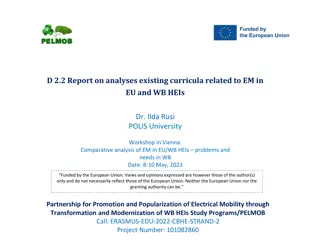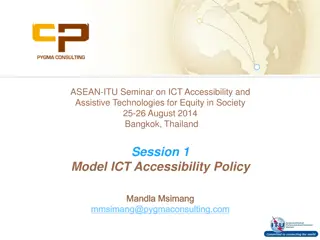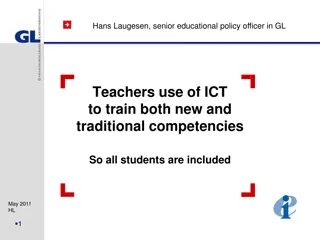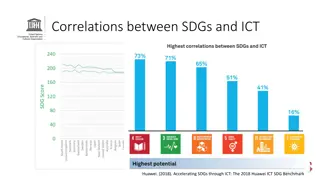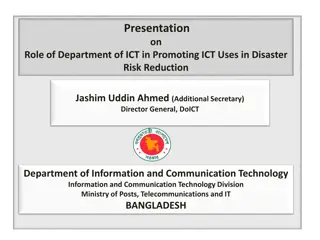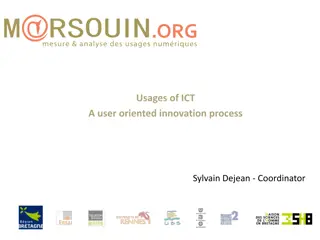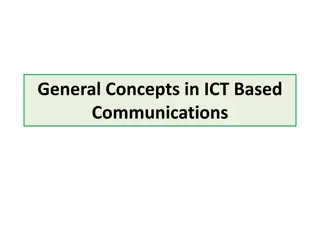ICT Industry in Western Balkans: Growth and Challenges
The ICT industry in the Western Balkans region has shown steady growth, becoming an important employer and contributing significantly to the GDP. A recent workforce assessment report highlights the constraints and challenges faced by ICT companies in terms of skill availability. Recommendations have been made to enhance the industry further.
Download Presentation

Please find below an Image/Link to download the presentation.
The content on the website is provided AS IS for your information and personal use only. It may not be sold, licensed, or shared on other websites without obtaining consent from the author.If you encounter any issues during the download, it is possible that the publisher has removed the file from their server.
You are allowed to download the files provided on this website for personal or commercial use, subject to the condition that they are used lawfully. All files are the property of their respective owners.
The content on the website is provided AS IS for your information and personal use only. It may not be sold, licensed, or shared on other websites without obtaining consent from the author.
E N D
Presentation Transcript
USAID ECONOMIC DEVELOPMENT, GOVERNANCE AND ENTERPRISE GROWTH PROJECT (EDGE) USAID PROJECT - PARTNERSHIP FOR BETTER BUSINESS REGULATION
Workforce Assessment Report ICT Industry Objective: To provide a comprehensive picture of the constraints and challenges of the companies in the ICT industry, in the region of Western Balkans, in relation to skills and availability of labor they need to operate effectively and to grow and to offer recommendations for improvements. Methodology: Online survey of 134 ICT companies Direct interviews with ICT companies Direct interviews with business associations Data from: State Statistical Offices of Individual Countries; Data from other available reports and studies (including WTO, World Bank etc.).
CONTENTS ICT industry in the countries of Western Balkans Region Education system Online survey of ICT companies Interviews Experiences and challenges before the ICT companies Role of the associations Conclusions Recommendations
ICT Industry in the Western Balkans Region Steady growth in the last five years Important employer Increase in exports of ICT services An industry with an important contribution to the GDP
ICT Industry in the Western Balkans Region GDP added value - Computer programming, consultancy and related activities; information service activities (%) GDP added value - ICT (%) 6,00 5,00 8.0% 2,00 4,00 1,80 8.4% 1,60 3,00 1,40 14.2% 1,20 8.4% annual growth 2,00 1,00 0,80 1,00 0,60 0,40 0,00 0,20 Albania Bosnia and Herzegovina Kosovo Montenegro North Macedonia Serbia 0,00 Albania Bosnia and Herzegovina North Macedonia Serbia 2014 2015 2016 2017 2018 2014 2015 2016 2017 2018 Sources: Individual countries statistical offices (online statistical databases)
ICT Industry in the Western Balkans Region Commercial services exports by sector and partner - BOP6 - SI - Telecommunications, computer, and information services * ($US million) Source: WTO, data.wto.org, accessed on November 30, 2020 *Countries included: Albania, Bosnia and Herzegovina, Montenegro, North Macedonia, Serbia
ICT Industry in the Western Balkans Region BOP6 - SI - Telecommunications, computer, and information services - exports (US$ per 100 people) 25.000 Serbia 20.000 15.000 Montenegro 10.000 North Macedonia Bosnia and Herzegovina 5.000 Kosovo Albania 0 2014 2015 2016 2017 2018 2019 Albania Bosnia and Herzegovina Kosovo Montenegro North Macedonia Serbia Source: World Bank, https://tcdata360.worldbank.org, accessed on December 07, 2020
ICT Industry in the Western Balkans Region BOP6 - SI - Telecommunications, computer, and information services - exports (US$ per 100 people) 40.000 Slovenia 35.000 30.000 25.000 Serbia 20.000 15.000 Montenegro 10.000 North Macedonia Bosnia and Herzegovina Albania 5.000 Kosovo 0 2014 2015 2016 2017 2018 2019 Albania Bosnia and Herzegovina Kosovo Montenegro North Macedonia Serbia Slovenia Source: World Bank, https://tcdata360.worldbank.org, accessed on December 07, 2020
ICT Industry in the Western Balkans Region *Fixed broadband subscriptions (per 100 people) 35 30 25 20 15 10 5 0 Albania Bosnia and Herzegovina Montenegro North Macedonia Serbia Slovenia 2012 2013 2014 2015 2016 2017 2018 2019 Source: WTO, data.wto.org, accessed on November 30, 2020 *Countries included: Albania, Bosnia and Herzegovina, Montenegro, North Macedonia, Serbia (and Slovenia)
Education System in Western Balkans Formal and informal education The formal education system consists of Primary Education Secondary Education Vocational & Post-secondary Non-Tertiary Tertiary Education Bologna programs are applied at the universities in the region.
Education System in Western Balkans About *27% of the graduates (26000 graduates) from tertiary education in the Western Balkans Region come from: Science, Technology, Engineering and Mathematics programs (23%) Natural Sciences, Mathematics and Statistics programs (4%) Annual number of graduated students from tertiary education in the ICT is about 9% of the total number of graduated students or about 8500 ICT graduates. *Source: World Bank, https://databank.worldbank.org, accessed on December 1, 2020
ICT in the Western Balkans Region - Labor Market In 2018 ICT sector employed about 150,000 people approx. 2.9% of all registered employees in the region The number of employees is even larger if we take into consideration ICT experts employed in other companies (larger production companies, banks, government) Table: Number of employees in ICT Bosnia and Herzegovina 572.958 North Macedonia 759.054 15.303 *Albania *Kosovo Montenegro Serbia Total Total Number of Employees ICT employees Computer programming, consultancy and related activities ICT as % of total number of employees Computer programming, consultancy and related activities as % of total number of employees Computer programming, consultancy and related activities as % of ICT employees 1.137.939 32.000 345.100 9.663 190.132 5.274 2.131.079 63.935 5.136.262 147.693 21.518 10.241 2,8% 5.947 3,8% 3.175 2,8% 1.061 2,8% 6.754 2,0% 27.656 3,0% 54.834 2,9% 0,9% 1,0% 0,9% 0,6% 0,9% 1,3% 1,1% 32,0% 27,6% 32,9% 20,1% 44,1% 43,3% 37,1% * Estimated Sources: Individual countries statistical offices (online statistical databases)
ICT in the Western Balkans Region - Labor Market ICT - average net wages by country (in Euro) Average Net Wages in 2019 (or 2018) 2017 2018 2019 Albania Bosnia and Herzegovina Kosovo Montenegro North Macedonia Serbia / 622 659 717 703 874 702 / 424 485 558 510 436 466 628 718 / / / 697 683 803 825 / ICT - average net wages by subsector (in Euro) Computer programming, consultancy and related Telecommunications 2018 2019 2018 2019 North Macedonia Serbia 724 658 671 735 1.059 925 1.029 1.081 Sources: Individual countries statistical offices (online statistical databases)
ICT Industry in the Western Balkans Region Data for 2018 BOSNIA AND HERZEGOVINA: ICT % of GDP: 4.12 IT % of GDP: 1.62 ICT % of all employees : 3.76% (21,518) # of ICT companies: 1468 ICT services exports: 159 million $US SERBIA: ICT % of GDP: 4.8 IT % of GDP: 1.9 ICT % of all employees: 3.1% (63,935) # of ICT companies: 4935 ICT services exports: 1592 million $US MONTENEGRO: ICT % of GDP: 3.69 IT % of GDP: n/a ICT % of all employees : 2.77% (5,274) # of ICT companies: n/a ICT services exports: 63 million $US KOSOVO: ICT % of GDP: 1.9 IT % of GDP: n/a ICT % of all employees: n/a (9,600 est.) # of ICT companies: 982 ICT services exports: n/a ALBANIA: ICT % of GDP: 3.26 IT % of GDP: 0.67 ICT % of all employees : 2.8% (32,000 est.) # of ICT companies: 2483 ICT services exports: 108 million $US NORTH MACEDONIA: ICT % of GDP: 2.9 IT % of GDP: 1.26 ICT % of all employees : 2.02% (15,303) # of ICT companies: 1856 ICT services exports: 235 million $US Sources: Individual countries statistical offices (online statistical databases); World Trade Organization (https://data.wto.org)
Survey of ICT companies Characteristics of respondents 134 companies surveyed (1.04% of all ICT enterprises in the WB region, or 2.06% of enterprises in the computer programming and consultancy segment) Surveyed companies by country and size (in %) Size of surveyed companies: 30% micro (40) 51% small (69) 16% medium (22) 3% large(4) 100% 80% 60% 40% 20% 0% Albania (8) Bosnia and Herzegovina (14) Kosovo (32) Montenegro (15) North Macedonia (33) Serbia (32) Total (134) Up to 10 employees (micro) from 11 to 50 employees (small) from 51 to 250 employees (average) more than 250 employees (large)
Survey of ICT companies Main Business Activity Majority of surveyed companies (66%) are involved in providing ICT consulting services Most of the companies that stated to have combination of other activities (95% or 34 companies) also include ICT consulting services The combination of main activities is more represented in the micro and small companies Main Business Activity 66% 70% 60% 50% 40% 27% 30% 20% 10% 3% 2% 1% 0% Training provider Provider of ICT consulting services Hardware distribution (wholesale) Retail sale of equipment and accessories Combination of the above
Survey of ICT companies Employees turnover 5591 employees at the surveyed companies 4% of all employees in the ICT in the region, or 10% of all employees in computer programming, consultancy and related services 65% / 35% male to female ratio at the surveyed companies tertiary education trends indicate changes in this ratio towards making the difference smaller *In the period 2014 to 2019 the ratio male/female of graduated students in ICT has changed from 60%/40% to 53%/47%. Fulltime employees by gender as % of all fulltime employees 100% 80% 60% 40% 20% 0% Albania Bosnia and Herzegovina Kosovo Montenegro North Macedonia Serbia Total * Data for graduated students in ICT in North Macedonia (source: State Statistical Office, Annual Publications on Number of Graduated Students) 004. Full time male employees 005. Full time female employees
Survey of ICT companies Employees turnover Use of seasonal workers was noted in 16% of the companies (21 companies) Percentage of surveyed companies that use seasonal labor (N=21) Average number of days per seasonal worker 140 60% 120 50% 100 40% 80 30% 60 20% 40 10% 20 0% 0 Albania Bosnia and Herzegovina Kosovo Montenegro North Macedonia Serbia Albania Bosnia and Herzegovina Kosovo Montenegro North Macedonia Serbia Total
Survey of ICT companies Sales analysis 100 companies, or 74% of surveyed companies, stated that they export their services, The analyzed levels of export sales indicate that the companies are either mostly focused on the domestic market or their focus is placed on the export markets Level of export sales of the exporting companies (in %) (N=100) Level of export sales of the exporting companies (in %) (N=100) 50% 90% 44% 45% 40% 80% 40% 70% 35% 60% 30% 50% 25% 40% 20% 30% 15% 20% 8% 8% 10% 10% 5% 0% 0% Albania Bosnia and Herzegovina Kosovo Montenegro North Macedonia Serbia Total <= 30% 30% - 60% 61% - 80% >=81% <= 30% 31% - 60% 61% - 80% >=81% Level of sales on export markets as % of total sales
Survey of ICT companies Sales analysis Expectations for Sales in 2020 Expected average decrease / increase of sales in 2020 Amidst the coronavirus challenge, the expectations for 2020 for the companies vary 40% 37% 40% 33% 35% 35% 30% 35% 30% 30% 26% 25% 25% 20% 20% 15% 15% 10% 10% 5% 5% 0% 0% Sales will decrease Sales will stay at same level Sales will increase Expected average sales decrease in 2020 Expected average increase in sales in 2020 Expectations for Sales in 2020 80% 60% 40% 20% 0% Albania Bosnia and Herzegovina Kosovo Montenegro North Macedonia Serbia Total Sales will decrease Sales will stay at same level Sales will increase
Survey of ICT companies Certifications in the ICT industry In regard to certifications, more than half of the surveyed companies (74 companies or 55% of all surveyed companies) have stated that they are certified for standards relevant for the ICT industry. 34 companies (26%) have already been certified, or are in process for certification for the quality management system ISO 9001
Survey of ICT companies Fluctuation of employees in the ICT industry 68% of the survey companies (91 companies) did not have changes in the number of employees Changes in the number of employees in the last 12 months 100% 88% 88% 87% 82% 80% 68% 64% 59% 60% 41% 36% 40% 32% 18% 13% 20% 13% 13% 0% Albania Bosnia and Herzegovina Kosovo Montenegro North Macedonia Serbia Total Yes No
Survey of ICT companies Fluctuation of employees in the ICT industry 43 companies (32%) had changes in number of employees in the last 12 months The level of change in number of employees was less than 10% from the total number of employees for 49% of the companies that had changes Finding new employees was partly or very difficult for 77% of these companies Changes in the number of employees (N=43) Was finding new employees easy? (N=43) 60% 45% 42% 49% 50% 40% 35% 35% 40% 30% 30% 25% 26% 23% 19% 20% 20% 15% 10% 10% 5% 5% 2% 0% 0% Yes Partly yes No n/a 1 - 10 (%) 11 - 25 (%) 26 - 50 (%) no answer
Survey of ICT companies Trainings in the ICT industry Trainings are important for the ICT sector. Close to 80% of the surveyed companies stated that their employees had attended courses or trainings in the last 12 months. The companies mostly use the training services organized by private consulting firms (31% of all answers), as well as training organized by other projects (31%). VET centers and Business associations are used by 14% of the surveyed companies. Training Providers Other projects 31% 70% 60% Government institutions 2% 50% 40% Private consulting companies 31% 30% Business 20% 14% associations/Chambers 10% Higher education institutions (universities) 0% 8% Albania Bosnia and Herzegovina Kosovo Montenegro North Macedonia Serbia Total Vocational education training centers 14% Vocational education training centers Business associations/Chambers Government institutions Higher education institutions (universities) Private consulting companies Other projects 0% 20% 40%
Survey of ICT companies Trainings in the ICT industry Companies are, in general, satisfied with the quality of trainings organized by VET centers and universities. Satisfaction with training 65% 70% 61% 60% 50% 40% 28% 30% 21% 20% 14% 11% 10% 0% Great Good Not Great Good Not satisfactory satisfactory Higher education institutions (universities) Vocational education training centers
Survey of ICT companies Trainings in the ICT industry Over 90% of the companies (124) stated that their employees need further professional improvements in skills within the organization s functions and soft skills Skills within organization's functions - Training Requirements (312 answers) Soft Skills - Training Requirements (402 answers) Skills for quality standards 13% Other skills 4% Teaching skills 3% Finance / Financial Management Skills 8% Informatics literacy and ICT skills 14% Sales and sales management skills 19% Creativity and innovation skills 14% Knowledge and use of foreign languages 9% Management skills 22% Teamwork and team building 16% Marketing skills 18% Problem solving skills 18% Production-related skills (technology) Communication and presentation skills 20% 23% 0% 10% 20% 30% 0% 10% 20% 30%
Survey of ICT companies Availability of labor force in the next three years The companies believe there will be no competent and well-trained workforce in the next three years
Survey of ICT companies Contacts and cooperation with labor providers and internship opportunities Contacts with labor providers and internship opportunities Formal contacts with potential providers of required workforce No, we have no contact and cooperation 23% Other 12% Lifetime Learning Centers 2% Vocational education and training centers 12% Employment agencies 11% With faculties / universities 33% With secondary vocational schools 6% 0% 10% 20% 30% 40%
Survey of ICT companies Availability of training providers There are training providers available locally that meet the requirements of the ICT companies partly (58%); It is very difficult to find qualified local training providers (25%).
Survey of ICT companies Internship opportunities Most of the companies (88% or 118 companies) offer internships The companies that do not offer internship are micro and small companies Number of companies with interns at the time of the survey Number of companies with interns at the time of the survey 70% 46% 50% 60% 42% 50% 40% 40% 30% 30% 20% 20% 10% 12% 0% 10% Albania Bosnia and Herzegovina Kosovo Montenegro North Macedonia Serbia Total 0% Yes No No answer Yes No No answer
Survey of ICT companies Government policies and strategies Most of the surveyed companies are partly familiar with current government policies and strategies Policies and strategies partly meet the expectation or are inappropriate Current policies and strategies are poorly designed and implemented Characteristics of current programs and policies for labor development and employment Familiarity with current government policies and strategies Opinion of the companies about current programs and policies No answer No answer No answer 4% 1% 2% Both policies and action plans are well designed and implemented They are inappropriate and don't meet my company expectations No, I'm not familiar with this question 4% 25% 34% Policies are well designed, but operational/action plans are poorly I am partly familiar with current programs and policies They partially meet the expectations of my company and the industry 32% 54% 59% Yes, I am fully acquainted with the programs and policies Efficient and stimulating for my company and the industry Current policies need to be redesigned 60% 20% 4% 0% 50% 100% 0% 20% 40% 60% 0% 50% 100%
Survey of ICT companies Popularization of jobs offered in the ICT industry Internships and practical work (36%) Career fairs or fairs for vocational education and training (28%) How to contribute to popularization of jobs offered in the ICT industry? No answer 6% Other 17% Participation in career fairs or fairs for vocational education and training 28% Organizing internships or practical training for secondary vocational students 36% Support in organizing individual or smaller groups of job shadowing 10% Support secondary vocational schools to visit your facilities 4% 0% 10% 20% 30% 40%
Survey of ICT companies Other comments Total of 32 comments: Education system (60% of all comments), More practical work for students, Reforms in the education system to correspond to the market needs Promotion of life-long learning Government interventions (31% of comments), Incentives Better conditions for the teaching staff Market aspects Market developments and trends.
Interviews with companies Interviews with companies Most of the ICT companies hire university graduates. Newcomers are not well prepared. Companies invest between six months to one year for the training of the newcomers. Exceptions are students that had practical work or have done freelancing work during their studies. In addition to ICT skills, employees may be required to have other knowledge (e.g. design and implementation of ERP systems).
Interviews with companies Interviews with companies Cooperation with high schools and universities are established by medium sized and large companies, who have sufficient human capacities (HR department). Good experiences from the cooperation with high schools and universities is seen in the fact that companies can establish contacts with the future engineers and may influence their career path and/or choice of technology. Bad experiences are mostly concerned with the slow communication and lack of dynamics on the part of the high schools and universities. Technologies and markets are changing rapidly and educational institutions are not able to follow the market changes.
Interviews with companies Interviews with companies There is a deficit of well-trained experienced ICT engineers There is a deficit of well-trained and experienced people for marketing and sales of digital products Internships have proven to be very successful way for recruiting new staff Practical work during studies would be beneficial to achieve better prepared young people for the ICT industry ICT related subjects, specifically programming, should be introduced at the other faculties (including medical schools).
Interviews with associations Interviews with ICT associations Associations are closely monitoring the changes in the technologies and trends Information of training requirements: Daily communications with the members Regular business meetings with the members Regular annual surveys Regular contacts with VET schools and universities Specialized technical trainings can be expensive, and some of the SMEs cannot finance the training. International donor support is welcome.
Interviews with associations Interviews with ICT associations External training is mostly used by the companies when there is some kind of certification related to and required for their work. Promotion of the concepts of life-long learning and collaborative learning on all levels. The number of certified trainers is still low, although increasing in the last several years.
Conclusions ICT companies: Most of the companies are micro or small this may mean lack of management functions and/or skills within the company; ICT companies specialize working: Mostly on the local market(s), or Mostly subcontracting for export markets (with exceptions) Local markets are small; There are great potentials for export of ICT services; Lack of well trained and experienced new employees; Companies invest time and resources for the training.
Conclusions ICT experts: The employees in the industry are mostly engineers; The students are interested in the ICT sector because of the working conditions, wages and the possibilities for personal growth; Continuous education is required for both technical and soft skills.
Conclusions Education: The cooperation with the educational institutions is mostly carried out by larger companies who have HR departments; Companies are relatively satisfied with the level of quality of trainings provided by the local providers, universities and VETs; The companies are not happy with the speed the curricula is adapted to the market changes, at the relevant educational organizations; Developing new curricula takes time and resources and is a procedure; There are private companies that provide training and education services. Some of the larger companies have their own training academies; Specialized training and certifications can be very expensive.
Conclusions Associations: There is lack of sufficient communication between ICT companies, academia, employment agencies and government. Governments need to see the broader picture on the contribution of the ICT to the local economies The roles of the Associations are: to successfully bring the two sides, the recipients of training and the providers of training, closer to promote the industry and to lobby before the government and its institutions help companies, where possible, access financing for training purposes.
Conclusions Markets and market potentials: Countries in the region do not use the full potentials of their ICT capacities, Lack of market information and international marketing and promotion activities; Lack of adequate cooperation between the ICT companies Issues of contracts, protection of property rights
Recommendations Institutional support: Support marketing and promotion for the ICT industry Support branding - both local and regional Improve and make the access to finance easier for the ICT companies when they need financing for development of new products (collateral) Tax and other financial incentives Sensitive issue - but indirectly there is a non-equal treatment for IT companies who work on the local market and those who work abroad (meeting the IT requirements of the local economies)
Recommendations Education: Obligatory IT subjects in primary education starting from lower levels of education (programming, informatics); Introduction of obligatory practical education and its full implementation in real business environment, for the students in the secondary and tertiary education; Introduce procedures for quicker adaptation of the curricula to the needs of the ICT companies; Promotion of life-long learning and collaborative learning on all levels of education.
Recommendations Role of associations: Integrators of all stakeholders in the ICT industry Increase membership Accumulate and disseminate market trends and potentials data Develop services/products, including training
















